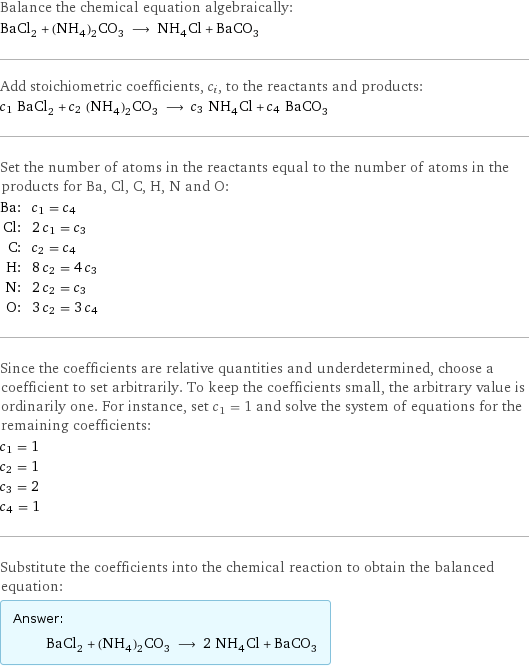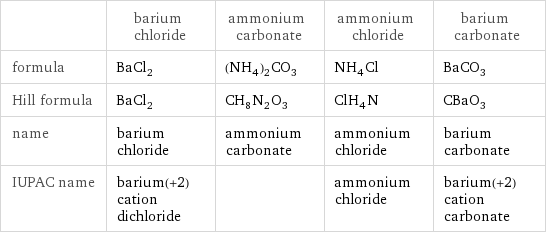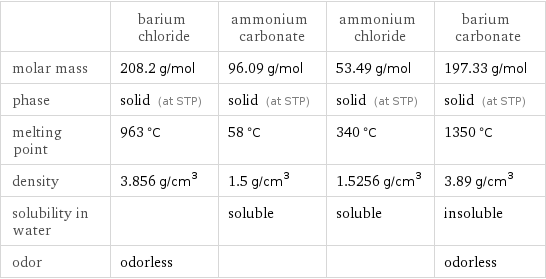Input interpretation

BaCl_2 barium chloride + (NH_4)_2CO_3 ammonium carbonate ⟶ NH_4Cl ammonium chloride + BaCO_3 barium carbonate
Balanced equation

Balance the chemical equation algebraically: BaCl_2 + (NH_4)_2CO_3 ⟶ NH_4Cl + BaCO_3 Add stoichiometric coefficients, c_i, to the reactants and products: c_1 BaCl_2 + c_2 (NH_4)_2CO_3 ⟶ c_3 NH_4Cl + c_4 BaCO_3 Set the number of atoms in the reactants equal to the number of atoms in the products for Ba, Cl, C, H, N and O: Ba: | c_1 = c_4 Cl: | 2 c_1 = c_3 C: | c_2 = c_4 H: | 8 c_2 = 4 c_3 N: | 2 c_2 = c_3 O: | 3 c_2 = 3 c_4 Since the coefficients are relative quantities and underdetermined, choose a coefficient to set arbitrarily. To keep the coefficients small, the arbitrary value is ordinarily one. For instance, set c_1 = 1 and solve the system of equations for the remaining coefficients: c_1 = 1 c_2 = 1 c_3 = 2 c_4 = 1 Substitute the coefficients into the chemical reaction to obtain the balanced equation: Answer: | | BaCl_2 + (NH_4)_2CO_3 ⟶ 2 NH_4Cl + BaCO_3
Structures

+ ⟶ +
Names

barium chloride + ammonium carbonate ⟶ ammonium chloride + barium carbonate
Equilibrium constant
![Construct the equilibrium constant, K, expression for: BaCl_2 + (NH_4)_2CO_3 ⟶ NH_4Cl + BaCO_3 Plan: • Balance the chemical equation. • Determine the stoichiometric numbers. • Assemble the activity expression for each chemical species. • Use the activity expressions to build the equilibrium constant expression. Write the balanced chemical equation: BaCl_2 + (NH_4)_2CO_3 ⟶ 2 NH_4Cl + BaCO_3 Assign stoichiometric numbers, ν_i, using the stoichiometric coefficients, c_i, from the balanced chemical equation in the following manner: ν_i = -c_i for reactants and ν_i = c_i for products: chemical species | c_i | ν_i BaCl_2 | 1 | -1 (NH_4)_2CO_3 | 1 | -1 NH_4Cl | 2 | 2 BaCO_3 | 1 | 1 Assemble the activity expressions accounting for the state of matter and ν_i: chemical species | c_i | ν_i | activity expression BaCl_2 | 1 | -1 | ([BaCl2])^(-1) (NH_4)_2CO_3 | 1 | -1 | ([(NH4)2CO3])^(-1) NH_4Cl | 2 | 2 | ([NH4Cl])^2 BaCO_3 | 1 | 1 | [BaCO3] The equilibrium constant symbol in the concentration basis is: K_c Mulitply the activity expressions to arrive at the K_c expression: Answer: | | K_c = ([BaCl2])^(-1) ([(NH4)2CO3])^(-1) ([NH4Cl])^2 [BaCO3] = (([NH4Cl])^2 [BaCO3])/([BaCl2] [(NH4)2CO3])](../image_source/d9f5a9fcc1c7bae7db63bb6a46035974.png)
Construct the equilibrium constant, K, expression for: BaCl_2 + (NH_4)_2CO_3 ⟶ NH_4Cl + BaCO_3 Plan: • Balance the chemical equation. • Determine the stoichiometric numbers. • Assemble the activity expression for each chemical species. • Use the activity expressions to build the equilibrium constant expression. Write the balanced chemical equation: BaCl_2 + (NH_4)_2CO_3 ⟶ 2 NH_4Cl + BaCO_3 Assign stoichiometric numbers, ν_i, using the stoichiometric coefficients, c_i, from the balanced chemical equation in the following manner: ν_i = -c_i for reactants and ν_i = c_i for products: chemical species | c_i | ν_i BaCl_2 | 1 | -1 (NH_4)_2CO_3 | 1 | -1 NH_4Cl | 2 | 2 BaCO_3 | 1 | 1 Assemble the activity expressions accounting for the state of matter and ν_i: chemical species | c_i | ν_i | activity expression BaCl_2 | 1 | -1 | ([BaCl2])^(-1) (NH_4)_2CO_3 | 1 | -1 | ([(NH4)2CO3])^(-1) NH_4Cl | 2 | 2 | ([NH4Cl])^2 BaCO_3 | 1 | 1 | [BaCO3] The equilibrium constant symbol in the concentration basis is: K_c Mulitply the activity expressions to arrive at the K_c expression: Answer: | | K_c = ([BaCl2])^(-1) ([(NH4)2CO3])^(-1) ([NH4Cl])^2 [BaCO3] = (([NH4Cl])^2 [BaCO3])/([BaCl2] [(NH4)2CO3])
Rate of reaction
![Construct the rate of reaction expression for: BaCl_2 + (NH_4)_2CO_3 ⟶ NH_4Cl + BaCO_3 Plan: • Balance the chemical equation. • Determine the stoichiometric numbers. • Assemble the rate term for each chemical species. • Write the rate of reaction expression. Write the balanced chemical equation: BaCl_2 + (NH_4)_2CO_3 ⟶ 2 NH_4Cl + BaCO_3 Assign stoichiometric numbers, ν_i, using the stoichiometric coefficients, c_i, from the balanced chemical equation in the following manner: ν_i = -c_i for reactants and ν_i = c_i for products: chemical species | c_i | ν_i BaCl_2 | 1 | -1 (NH_4)_2CO_3 | 1 | -1 NH_4Cl | 2 | 2 BaCO_3 | 1 | 1 The rate term for each chemical species, B_i, is 1/ν_i(Δ[B_i])/(Δt) where [B_i] is the amount concentration and t is time: chemical species | c_i | ν_i | rate term BaCl_2 | 1 | -1 | -(Δ[BaCl2])/(Δt) (NH_4)_2CO_3 | 1 | -1 | -(Δ[(NH4)2CO3])/(Δt) NH_4Cl | 2 | 2 | 1/2 (Δ[NH4Cl])/(Δt) BaCO_3 | 1 | 1 | (Δ[BaCO3])/(Δt) (for infinitesimal rate of change, replace Δ with d) Set the rate terms equal to each other to arrive at the rate expression: Answer: | | rate = -(Δ[BaCl2])/(Δt) = -(Δ[(NH4)2CO3])/(Δt) = 1/2 (Δ[NH4Cl])/(Δt) = (Δ[BaCO3])/(Δt) (assuming constant volume and no accumulation of intermediates or side products)](../image_source/3cf912a2421aee6a5a810f0eae865ad0.png)
Construct the rate of reaction expression for: BaCl_2 + (NH_4)_2CO_3 ⟶ NH_4Cl + BaCO_3 Plan: • Balance the chemical equation. • Determine the stoichiometric numbers. • Assemble the rate term for each chemical species. • Write the rate of reaction expression. Write the balanced chemical equation: BaCl_2 + (NH_4)_2CO_3 ⟶ 2 NH_4Cl + BaCO_3 Assign stoichiometric numbers, ν_i, using the stoichiometric coefficients, c_i, from the balanced chemical equation in the following manner: ν_i = -c_i for reactants and ν_i = c_i for products: chemical species | c_i | ν_i BaCl_2 | 1 | -1 (NH_4)_2CO_3 | 1 | -1 NH_4Cl | 2 | 2 BaCO_3 | 1 | 1 The rate term for each chemical species, B_i, is 1/ν_i(Δ[B_i])/(Δt) where [B_i] is the amount concentration and t is time: chemical species | c_i | ν_i | rate term BaCl_2 | 1 | -1 | -(Δ[BaCl2])/(Δt) (NH_4)_2CO_3 | 1 | -1 | -(Δ[(NH4)2CO3])/(Δt) NH_4Cl | 2 | 2 | 1/2 (Δ[NH4Cl])/(Δt) BaCO_3 | 1 | 1 | (Δ[BaCO3])/(Δt) (for infinitesimal rate of change, replace Δ with d) Set the rate terms equal to each other to arrive at the rate expression: Answer: | | rate = -(Δ[BaCl2])/(Δt) = -(Δ[(NH4)2CO3])/(Δt) = 1/2 (Δ[NH4Cl])/(Δt) = (Δ[BaCO3])/(Δt) (assuming constant volume and no accumulation of intermediates or side products)
Chemical names and formulas

| barium chloride | ammonium carbonate | ammonium chloride | barium carbonate formula | BaCl_2 | (NH_4)_2CO_3 | NH_4Cl | BaCO_3 Hill formula | BaCl_2 | CH_8N_2O_3 | ClH_4N | CBaO_3 name | barium chloride | ammonium carbonate | ammonium chloride | barium carbonate IUPAC name | barium(+2) cation dichloride | | ammonium chloride | barium(+2) cation carbonate
Substance properties

| barium chloride | ammonium carbonate | ammonium chloride | barium carbonate molar mass | 208.2 g/mol | 96.09 g/mol | 53.49 g/mol | 197.33 g/mol phase | solid (at STP) | solid (at STP) | solid (at STP) | solid (at STP) melting point | 963 °C | 58 °C | 340 °C | 1350 °C density | 3.856 g/cm^3 | 1.5 g/cm^3 | 1.5256 g/cm^3 | 3.89 g/cm^3 solubility in water | | soluble | soluble | insoluble odor | odorless | | | odorless
Units
